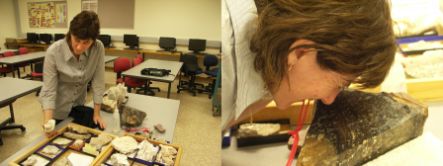Our Changing World for Thursday 2 December 2010
Public surgery at the zoo

Wellington Zoo's animal hospital and centre for native wildlife has two state-of-the-art veterinary operating theatres where wildlife, such as this little blue penguin, is treated. (images: Amelia Nurse and Francois Lampen)
Francois Lampen loves his job: one afternoon he's operating on a chimp, the next he's examining an injured albatross. Lampen is the head veterinarian at The Nest - Te Kōhanga, Wellington Zoo's animal hospital and centre for native wildlife. And he gets to share his love of his work too: every day there are procedures which are open to the public through a viewing gallery complete with audio and video screens, and step by step commentary. The $6-million purpose-built state of the art veterinary facility has two surgeries, a lab and space to house not only sick zoo animals but also native birds that have come to harm in the wild. It is approaching its first anniversary and Amelia Nurse went along to see how things are going.
Raman spectroscopy

At the University of Otago, Keith Gordon (above) is using Raman spectroscopy to analyse substances as diverse as drugs on clothes, the composition of gall stones, and the content of milk powder.
Named after one of its inventors, Indian scientist and Nobel prize winner Sir C. V. Raman, the technique can also be used to measure the electronic properties of light sensitive materials such as solar cells or light emitting diodes (LEDs). These materials change their molecular structure when exposed to light, as atoms jump into an "excited state". With specially-placed lasers, the vibrational spectrum of these excited states can be evaluated, and the materials then tweaked to improve their optical properties.
Ancient traces of life

Kathy Campbell with some of the rocks that have helped her decipher ancient environments, and looking closely at the fossil trail of a tiny snail grazing15- million-year-old bacterial mats. (images: Veronika Meduna)
Few people can pinpoint the beginning of their career, but Kathy Campbell still remembers the fossil that made her embark on palaeo-ecology, the study of ancient environments.
She was a Masters student in geology and mapping rocks on the coast of Washington in the US. The patterns in the sedimentary rocks were different, and she found an unusual fossil clam, but it wasn't until she attended a zoology class, that she learned that the gutless clam was living in a symbiotic relationship with bacteria and was highly adapted to survive in methane seeps and hydrothermal vents. She had discovered one of the first fossil hydrocarbon seep deposits in the world.
Today, Kathy Campbell combines geology and biology to study ancient extreme environments in New Zealand and overseas. In this interview, she describes the detective work it takes to decipher the fossilised traces of animals and microbial mats to paint a picture of what their world would have been like.